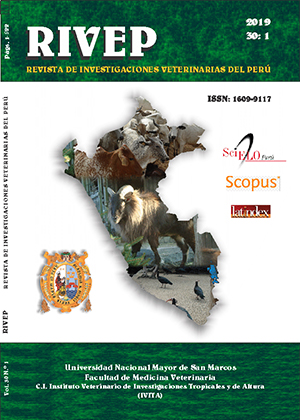Estimation of faecal excretion in alpacas (Vicugna pacos) in confinement conditions using titanium dioxide
DOI:
https://doi.org/10.15381/rivep.v30i1.15765Keywords:
titanium dioxide; alpacas; faecal production; external markerAbstract
The aim of this study was to estimate the production of faeces in alpacas with the use of titanium dioxide (TiO2). A square 4x4 Latin design was used, with four animals, four treatments and four periods. Each period last for 14 days of evaluation and seven days of rest. The treatments were: T2.5 (1), 2.5 g of TiO2/animal/day; T1.25(2), 2.5 g of TiO2/animal/day divided into two doses (07:00, 16:00); T5(1), 5 g of TiO2/animal/day; T2.5(2), 5 g of TiO2/animal/day divided into two doses (07:00, 16:00). The percentages of the recovery of TiO2 were 90, 82, 78 and 52% for T2.5(1), T1.25(2), T5(1) and T2.5(2), respectively, being T2.5(2) different from the other treatments (p=0.00013). The parameters of the TiO2 excretion pattern were: intercept of the curve of TiO2 excretion at time zero (a), maximum excretion of TiO2 at time (b), constant rate of excretion of b (c), time needed of excretion of TiO2 so that it has excreted half of the initial concentration (T1/2), and time to reach the balance of excretion of the marker (T (a+b)). There was no difference between treatments for the values of a, c, mean T and T, but there was a significant difference in the value of b between the administration of the marker of 2.5 vs 5 g (p<0.0001). The averages of faecal production estimated with TiO2 vs. faecal production observed directly was different in T1.25(2), T5(1) and T2.5(2) (p<0.05), but not in T2.5(1). In conclusion, the time in which the excretion equilibrium of TiO2 is reached is approximately eight days and the dose of 2.5 g of TiO2 once a day more accurately estimates faecal production in alpacas.
Downloads
Downloads
Published
Issue
Section
License
Copyright (c) 2019 Carlos Vílchez P., Rosina Camargo H., Juan Olazábal L., Felipe San Martín H..

This work is licensed under a Creative Commons Attribution-NonCommercial-ShareAlike 4.0 International License.
AUTHORS RETAIN THEIR RIGHTS:
a. Authors retain their trade mark rights and patent, and also on any process or procedure described in the article.
b. Authors retain their right to share, copy, distribute, perform and publicly communicate their article (eg, to place their article in an institutional repository or publish it in a book), with an acknowledgment of its initial publication in the Revista de Investigaciones Veterinarias del Perú (RIVEP).
c. Authors retain theirs right to make a subsequent publication of their work, to use the article or any part thereof (eg a compilation of his papers, lecture notes, thesis, or a book), always indicating the source of publication (the originator of the work, journal, volume, number and date).










